AT45DB041E
4-Mbit DataFlash (with Extra 128-Kbits), 1.65V Minimum
SPI Serial Flash Memory
Features
Single 1.65V - 3.6V supply
Serial Peripheral Interface (SPI) compatible
Supports SPI modes 0 and 3
Supports RapidS™ operation
Continuous read capability through entire array
Up to 85MHz
Low-power read option up to 15 MHz
Clock-to-output time (tV) of 6ns maximum
User configurable page size
256 bytes per page
264 bytes per page (default)
Page size can be factory pre-configured for 256 bytes
Two fully independent SRAM data buffers (256/264 bytes)
Allows receiving data while reprogramming the main memory array
Flexible programming options
Byte/Page Program (1 to 256/264 bytes) directly into main memory
Buffer Write
Buffer to Main Memory Page Program
Flexible erase options
Page Erase (256/264 bytes)
Block Erase (2KB)
Sector Erase (64KB)
Chip Erase (4-Mbits)
Program and Erase Suspend/Resume
Advanced hardware and software data protection features
Individual sector protection
Individual sector lockdown to make any sector permanently read-only
128-byte, One-Time Programmable (OTP) Security Register
64 bytes factory programmed with a unique identifier
64 bytes user programmable
Hardware and software controlled reset options
JEDEC Standard Manufacturer and Device ID Read
Low-power dissipation
400nA Ultra-Deep Power-Down current (typical)
3µA Deep Power-Down current (typical)
25µA Standby current (typical)
7mA Active Read current (typical @ 15 MHz))
Endurance: 100,000 program/erase cycles per page minimum
Data retention: 20 years
Complies with full industrial temperature range
Green (Pb/Halide-free/RoHS compliant) packaging options
8-lead SOIC (0.150" wide and 0.208" wide)
8-pad Ultra-thin DFN (5 x 6 x 0.6mm)
8-ball Wafer Level Chip Scale Package
Die in Wafer Form(1)
Note: 1. Contact factory for availability.
8783L–DFLASH–7/2017
�
Description
The AT45DB041E is a 1.65V minimum, serial-interface sequential access Flash memory ideally suited for a wide variety
of digital voice, image, program code, and data storage applications. The AT45DB041E also supports the RapidS serial
interface for applications requiring very high speed operation. Its 4,194,304 bits of memory are organized as 2,048 pages
of 256 bytes or 264 bytes each. In addition to the main memory, the AT45DB041E also contains two SRAM buffers of
256/264 bytes each. The buffers allow receiving of data while a page in the main memory is being reprogrammed.
Interleaving between both buffers can dramatically increase a system's ability to write a continuous data stream. In
addition, the SRAM buffers can be used as additional system scratch pad memory, and E2PROM emulation (bit or byte
alterability) can be easily handled with a self-contained three step read-modify-write operation.
Unlike conventional Flash memories that are accessed randomly with multiple address lines and a parallel interface, the
DataFlash® uses a serial interface to sequentially access its data. The simple sequential access dramatically reduces
active pin count, facilitates simplified hardware layout, increases system reliability, minimizes switching noise, and
reduces package size. The device is optimized for use in many commercial and industrial applications where
high-density, low-pin count, low-voltage, and low-power are essential.
To allow for simple in-system re-programmability, the AT45DB041E does not require high input voltages for
programming. The device operates from a single 1.65V to 3.6V power supply for the erase and program and read
operations. The AT45DB041E is enabled through the Chip Select pin (CS) and accessed via a 3-wire interface consisting
of the Serial Input (SI), Serial Output (SO), and the Serial Clock (SCK).
All programming and erase cycles are self-timed.
1.
Pin Configurations and Pinouts
Figure 1-1. Pinouts
8-lead SOIC
Top View
8-pad UDFN
Top View
(1)
(through package)
SI
SCK
RESET
CS
1
2
3
4
8
7
6
5
SO
GND
VCC
WP
SI
SCK
RESET
CS
1
2
3
4
8
7
6
5
SO
GND
VCC
WP
(2)
8-Ball WLCSP
Bottom View
Pin 1
WP
CS
VCC
RESET
GND
SCK
SO
SI
Note:
1. The metal pad on the bottom of the UDFN package is not internally connected to a voltage potential.
This pad can be a “no connect” or connected to GND.
2. Contact info@adestotech.com for manufacturing flow and availability.
AT45DB041E
8783L–DFLASH–7/2017
2
�
Table 1-1.
Pin Configurations
Symbol
CS
SCK
SI
SO
WP
RESET
VCC
GND
Name and Function
Chip Select: Asserting the CS pin selects the device. When the CS pin is deasserted, the
device will be deselected and normally be placed in the standby mode (not Deep Power-Down
mode) and the output pin (SO) will be in a high-impedance state. When the device is
deselected, data will not be accepted on the input pin (SI).
A high-to-low transition on the CS pin is required to start an operation and a low-to-high
transition is required to end an operation. When ending an internally self-timed operation such
as a program or erase cycle, the device will not enter the standby mode until the completion of
the operation.
Serial Clock: This pin is used to provide a clock to the device and is used to control the flow of
data to and from the device. Command, address, and input data present on the SI pin is
always latched on the rising edge of SCK, while output data on the SO pin is always clocked
out on the falling edge of SCK.
Serial Input: The SI pin is used to shift data into the device. The SI pin is used for all data input
including command and address sequences. Data on the SI pin is always latched on the rising
edge of SCK. Data present on the SI pin will be ignored whenever the device is deselected (CS
is deasserted).
Serial Output: The SO pin is used to shift data out from the device. Data on the SO pin is
always clocked out on the falling edge of SCK. The SO pin will be in a high-impedance state
whenever the device is deselected (CS is deasserted).
Write Protect: When the WP pin is asserted, all sectors specified for protection by the Sector
Protection Register will be protected against program and erase operations regardless of
whether the Enable Sector Protection command has been issued or not. The WP pin functions
independently of the software controlled protection method. After the WP pin goes low, the
contents of the Sector Protection Register cannot be modified.
If a program or erase command is issued to the device while the WP pin is asserted, the device
will simply ignore the command and perform no operation. The device will return to the idle
state once the CS pin has been deasserted. The Enable Sector Protection command and the
Sector Lockdown command, however, will be recognized by the device when the WP pin is
asserted.
The WP pin is internally pulled-high and may be left floating if hardware controlled protection
will not be used. However, it is recommended that the WP pin also be externally connected to
VCC whenever possible.
Reset: A low state on the reset pin (RESET) will terminate the operation in progress and reset
the internal state machine to an idle state. The device will remain in the reset condition as long
as a low level is present on the RESET pin. Normal operation can resume once the RESET pin
is brought back to a high level.
The device incorporates an internal power-on reset circuit, so there are no restrictions on the
RESET pin during power-on sequences. If this pin and feature is not utilized, then it is
recommended that the RESET pin be driven high externally.
Device Power Supply: The VCC pin is used to supply the source voltage to the device.
Operations at invalid VCC voltages may produce spurious results and should not be attempted.
Ground: The ground reference for the power supply. GND should be connected to the system
ground.
Asserted
State
Type
Low
Input
—
—
—
Input
Input
Output
Low
Input
Low
Input
—
—
Power
Ground
AT45DB041E
8783L–DFLASH–7/2017
3
�
2.
Block Diagram
Figure 2-1. Block Diagram
WP
Flash Memory Array
Page (256/264 bytes)
Buffer 1 (256/264 bytes)
Buffer 2 (256/264 bytes)
SCK
CS
RESET
VCC
GND
I/O Interface
SI
SO
AT45DB041E
8783L–DFLASH–7/2017
4
�
3.
Memory Array
To provide optimal flexibility, the AT45DB041E memory array is divided into three levels of granularity comprising of
sectors, blocks, and pages. Figure 3-1, Memory Architecture Diagram illustrates the breakdown of each level and details
the number of pages per sector and block. Program operations to the DataFlash can be done at the full page level or at
the byte level (a variable number of bytes). The erase operations can be performed at the chip, sector, block, or page
level.
Figure 3-1. Memory Architecture Diagram
Sector Architecture
Block Architecture
Page Architecture
Sector 0a = 8 pages
2,048/2,112 bytes
Sector 0b = 248 pages
63,488/65,472 bytes
Sector 1 = 256 pages
65,536/67,584 bytes
Sector 2 = 256 pages
65,536/67,584 bytes
Sector 6 = 256 pages
65,536/67,584 bytes
Sector 7 = 256 pages
65,536/67,584 bytes
8 Pages
Block 0
Block 1
Block 2
Block 30
Block 31
Block 32
Block 33
Block 62
Block 63
Block 64
Block 65
Sector 0a
b
0
r
o
t
c
e
S
1
r
o
t
c
e
S
2
r
o
t
c
e
S
0
k
c
o
B
l
1
k
c
o
B
l
Page 0
Page 1
Page 6
Page 7
Page 8
Page 9
Page 14
Page 15
Page 16
Page 17
Page 18
Block 254
Block 255
Block = 2,048/2,112 bytes
Page 2,046
Page 2,047
Page = 256/264 bytes
AT45DB041E
8783L–DFLASH–7/2017
5
�
4.
Device Operation
The device operation is controlled by instructions from the host processor. The list of instructions and their associated
opcodes are contained in Table 15-1 on page 40 through Table 15-4 on page 41. A valid instruction starts with the falling
edge of CS followed by the appropriate 8-bit opcode and the desired buffer or main memory address location. While the
CS pin is low, toggling the SCK pin controls the loading of the opcode and the desired buffer or main memory address
location through the SI (Serial Input) pin. All instructions, addresses, and data are transferred with the Most Significant
Bit (MSB) first.
Three address bytes are used to address memory locations in either the main memory array or in one of the SRAM
buffers. The three address bytes will be comprised of a number of dummy bits and a number of actual device address
bits, with the number of dummy bits varying depending on the operation being performed and the selected device page
size. Buffer addressing for the standard DataFlash page size (264 bytes) is referenced in the datasheet using the
terminology BFA8 - BFA0 to denote the 9 address bits required to designate a byte address within a buffer. The main
memory addressing is referenced using the terminology PA10 - PA0 and BA8 - BA0, where PA10 - PA0 denotes the
11 address bits required to designate a page address, and BA8 - BA0 denotes the 9 address bits required to designate a
byte address within the page. Therefore, when using the standard DataFlash page size, a total of 20 address bits are
used.
For the “power of 2” binary page size (256 bytes), the buffer addressing is referenced in the datasheet using the
conventional terminology BFA7 - BFA0 to denote the eight address bits required to designate a byte address within a
buffer. Main memory addressing is referenced using the terminology A18 - A0, where A18 - A8 denotes the 11 address
bits required to designate a page address, and A7 - A0 denotes the eight address bits required to designate a byte
address within a page. Therefore, when using the binary page size, a total of 19 address bits are used.
AT45DB041E
8783L–DFLASH–7/2017
6
�
5.
5.1
5.2
Read Commands
By specifying the appropriate opcode, data can be read from the main memory or from either one of the two SRAM data
buffers. The DataFlash supports RapidS protocols for Mode 0 and Mode 3. Please see Section 25., Detailed Bit-level
Read Waveforms: RapidS Mode 0/Mode 3 diagrams in this datasheet for details on the clock cycle sequences for each
mode.
Continuous Array Read (Legacy Command: E8h Opcode)
By supplying an initial starting address for the main memory array, the Continuous Array Read command can be utilized to
sequentially read a continuous stream of data from the device by simply providing a clock signal; no additional addressing
information or control signals need to be provided. The DataFlash incorporates an internal address counter that will
automatically increment on every clock cycle, allowing one continuous read from memory to be performed without the
need for additional address sequences. To perform a Continuous Array Read using the standard DataFlash page size
(264 bytes), an opcode of E8h must be clocked into the device followed by three address bytes (which comprise the 24-bit
page and byte address sequence) and four dummy bytes. The first 11 bits (PA10 - PA0) of the 20-bit address sequence
specify which page of the main memory array to read and the last nine (BA8 - BA0) of the 20-bit address sequence specify
the starting byte address within the page. To perform a Continuous Array Read using the binary page size
(256 bytes), an opcode of E8h must be clocked into the device followed by three address bytes and four dummy bytes.
The first 11 bits (A18 - A8) of the 19-bit address sequence specify which page of the main memory array to read and the
last eight bits (A7 - A0) of the 19-bit address sequence specify the starting byte address within the page. The dummy
bytes that follow the address bytes are needed to initialize the read operation. Following the dummy bytes, additional clock
pulses on the SCK pin will result in data being output on the SO (serial output) pin.
The CS pin must remain low during the loading of the opcode, the address bytes, the dummy bytes, and the reading of
data. When the end of a page in the main memory is reached during a Continuous Array Read, the device will continue
reading at the beginning of the next page with no delays incurred during the page boundary crossover (the crossover from
the end of one page to the beginning of the next page). When the last bit in the main memory array has been read, the
device will continue reading back at the beginning of the first page of memory. As with crossing over page boundaries, no
delays will be incurred when wrapping around from the end of the array to the beginning of the array.
A low-to-high transition on the CS pin will terminate the read operation and tri-state the output pin (SO). The maximum
SCK frequency allowable for the Continuous Array Read is defined by the fCAR1 specification. The Continuous Array Read
bypasses the data buffers and leaves the contents of the buffers unchanged.
Warning:
This command is not recommended for new designs.
Continuous Array Read (High Frequency Mode: 1Bh Opcode)
This command can be used to read the main memory array sequentially at the highest possible operating clock
frequency up to the maximum specified by fCAR4. To perform a Continuous Array Read using the standard DataFlash
page size (264 bytes), the CS pin must first be asserted, and then an opcode of 1Bh must be clocked into the device
followed by three address bytes and two dummy bytes. The first 11 bits (PA10 - PA0) of the 20-bit address sequence
specify which page of the main memory array to read and the last 9 bits (BA8 - BA0) of the 20-bit address sequence
specify the starting byte address within the page. To perform a Continuous Array Read using the binary page size (256
bytes), the opcode 1Bh must be clocked into the device followed by three address bytes (A18 - A0) and two dummy
bytes. Following the dummy bytes, additional clock pulses on the SCK pin will result in data being output on the SO
(Serial Output) pin.
The CS pin must remain low during the loading of the opcode, the address bytes, the dummy bytes, and the reading of
data. When the end of a page in the main memory is reached during a Continuous Array Read, the device will continue
reading at the beginning of the next page with no delays incurred during the page boundary crossover (the crossover
from the end of one page to the beginning of the next page). When the last bit in the main memory array has been read,
the device will continue reading back at the beginning of the first page of memory. As with crossing over page
boundaries, no delays will be incurred when wrapping around from the end of the array to the beginning of the array.
AT45DB041E
8783L–DFLASH–7/2017
7
�
5.3
5.4
A low-to-high transition on the CS pin will terminate the read operation and tri-state the output pin (SO). The maximum
SCK frequency allowable for the Continuous Array Read is defined by the fCAR1 specification. The Continuous Array
Read bypasses both data buffers and leaves the contents of the buffers unchanged.
Continuous Array Read (High Frequency Mode: 0Bh Opcode)
This command can be used to read the main memory array sequentially at higher clock frequencies up to the maximum
specified by fCAR1. To perform a Continuous Array Read using the standard DataFlash page size (264 bytes), the CS pin
must first be asserted, and then an opcode of 0Bh must be clocked into the device followed by three address bytes and
one dummy byte. The first 11 bits (PA10 - PA0) of the 20-bit address sequence specify which page of the main memory
array to read and the last 9 bits (BA8 - BA0) of the 20-bit address sequence specify the starting byte address within the
page. To perform a Continuous Array Read using the binary page size (256 bytes), the opcode 0Bh must be clocked into
the device followed by three address bytes (A18 - A0) and one dummy byte. Following the dummy byte, additional clock
pulses on the SCK pin will result in data being output on the SO pin.
The CS pin must remain low during the loading of the opcode, the address bytes, the dummy byte, and the reading of
data. When the end of a page in the main memory is reached during a Continuous Array Read, the device will continue
reading at the beginning of the next page with no delays incurred during the page boundary crossover (the crossover
from the end of one page to the beginning of the next page). When the last bit in the main memory array has been read,
the device will continue reading back at the beginning of the first page of memory. As with crossing over page
boundaries, no delays will be incurred when wrapping around from the end of the array to the beginning of the array.
A low-to-high transition on the CS pin will terminate the read operation and tri-state the output pin (SO). The maximum
SCK frequency allowable for the Continuous Array Read is defined by the fCAR1 specification. The Continuous Array
Read bypasses both data buffers and leaves the contents of the buffers unchanged.
Continuous Array Read (Low Frequency Mode: 03h Opcode)
This command can be used to read the main memory array sequentially at lower clock frequencies up to maximum
specified by fCAR2. Unlike the previously described read commands, this Continuous Array Read command for the lower
clock frequencies does not require the clocking in of dummy bytes after the address byte sequence. To perform a
Continuous Array Read using the standard DataFlash page size (264 bytes), the CS pin must first be asserted, and then
an opcode of 03h must be clocked into the device followed by three address bytes. The first 11 bits (PA10 - PA0) of the
20-bit address sequence specify which page of the main memory array to read and the last 9 bits (BA8 - BA0) of the
address sequence specify the starting byte address within the page. To perform a Continuous Array Read using the
binary page size (256 bytes), the opcode 03h must be clocked into the device followed by three address bytes (A18 -
A0). Following the address bytes, additional clock pulses on the SCK pin will result in data being output on the SO pin.
The CS pin must remain low during the loading of the opcode, the address bytes, and the reading of data. When the end
of a page in the main memory is reached during a Continuous Array Read, the device will continue reading at the
beginning of the next page with no delays incurred during the page boundary crossover (the crossover from the end of
one page to the beginning of the next page). When the last bit in the main memory array has been read, the device will
continue reading back at the beginning of the first page of memory. As with crossing over page boundaries, no delays will
be incurred when wrapping around from the end of the array to the beginning of the array.
A low-to-high transition on the CS pin will terminate the read operation and tri-state the output pin (SO). The maximum
SCK frequency allowable for the Continuous Array Read is defined by the fCAR2 specification. The Continuous Array
Read bypasses both data buffers and leaves the contents of the buffers unchanged.
5.5
Continuous Array Read (Low Power Mode: 01h Opcode)
This command is ideal for applications that want to minimize power consumption and do not need to read the memory
array at high frequencies. Like the 03h opcode, this Continuous Array Read command allows reading the main memory
array sequentially without the need for dummy bytes to be clocked in after the address byte sequence. The memory can
be read at clock frequencies up to maximum specified by fCAR3. To perform a Continuous Array Read using the standard
DataFlash page size (264 bytes), the CS pin must first be asserted, and then an opcode of 01h must be clocked into the
device followed by three address bytes. The first 11 bits (PA10 - PA0) of the 20-bit address sequence specify which page
AT45DB041E
8783L–DFLASH–7/2017
8
�
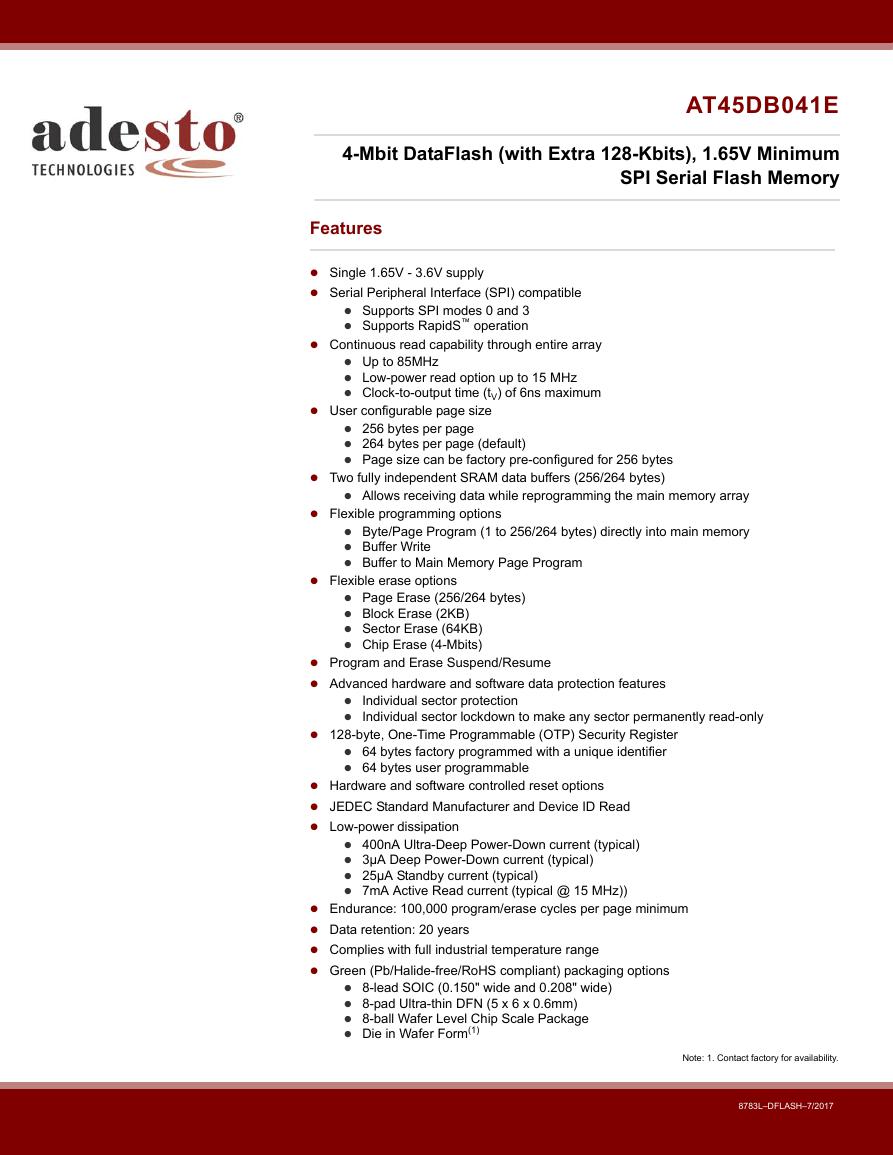
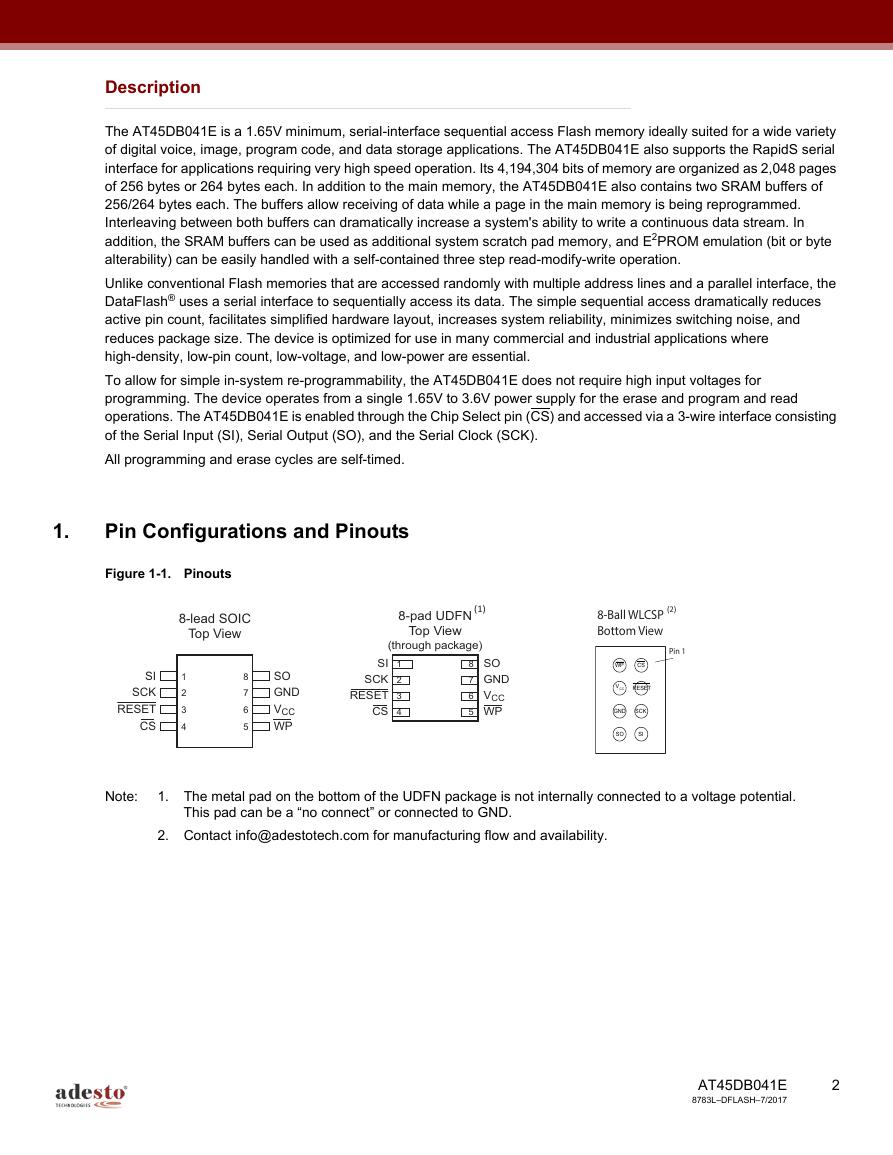
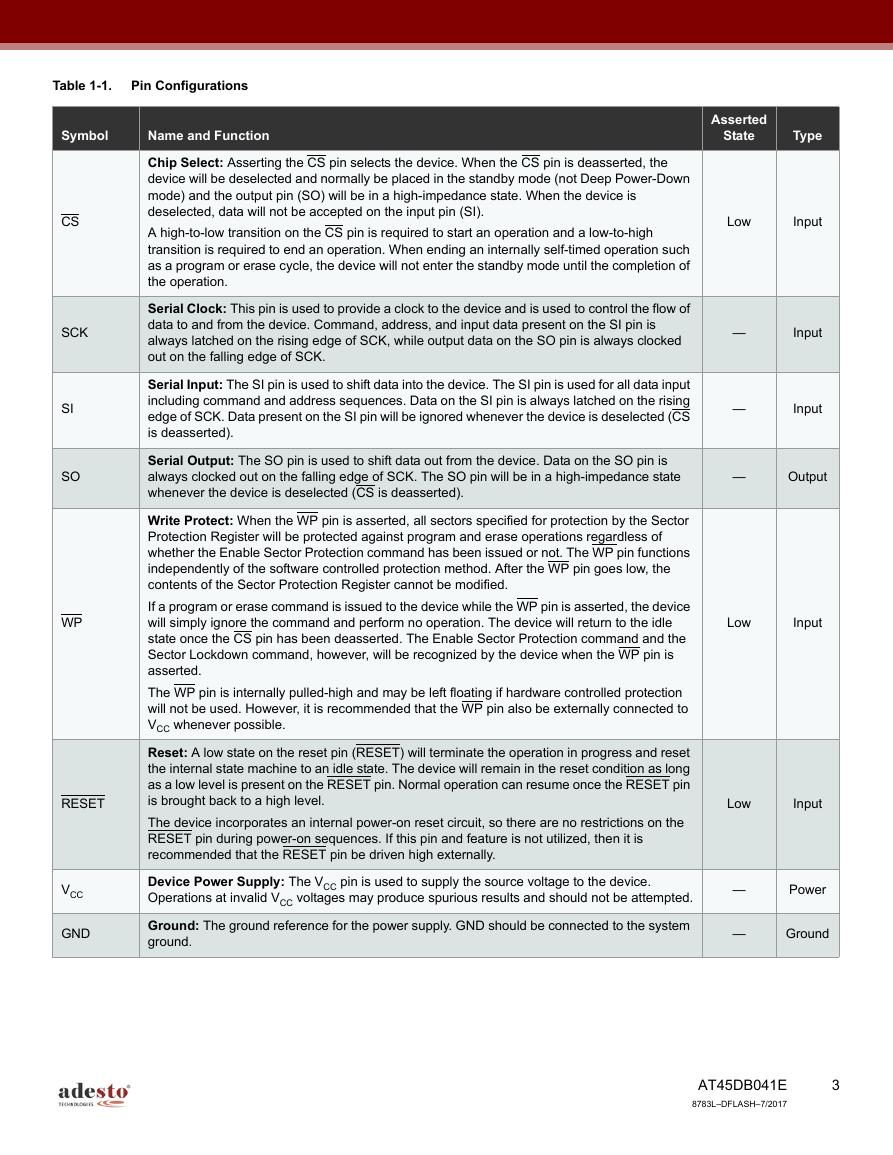
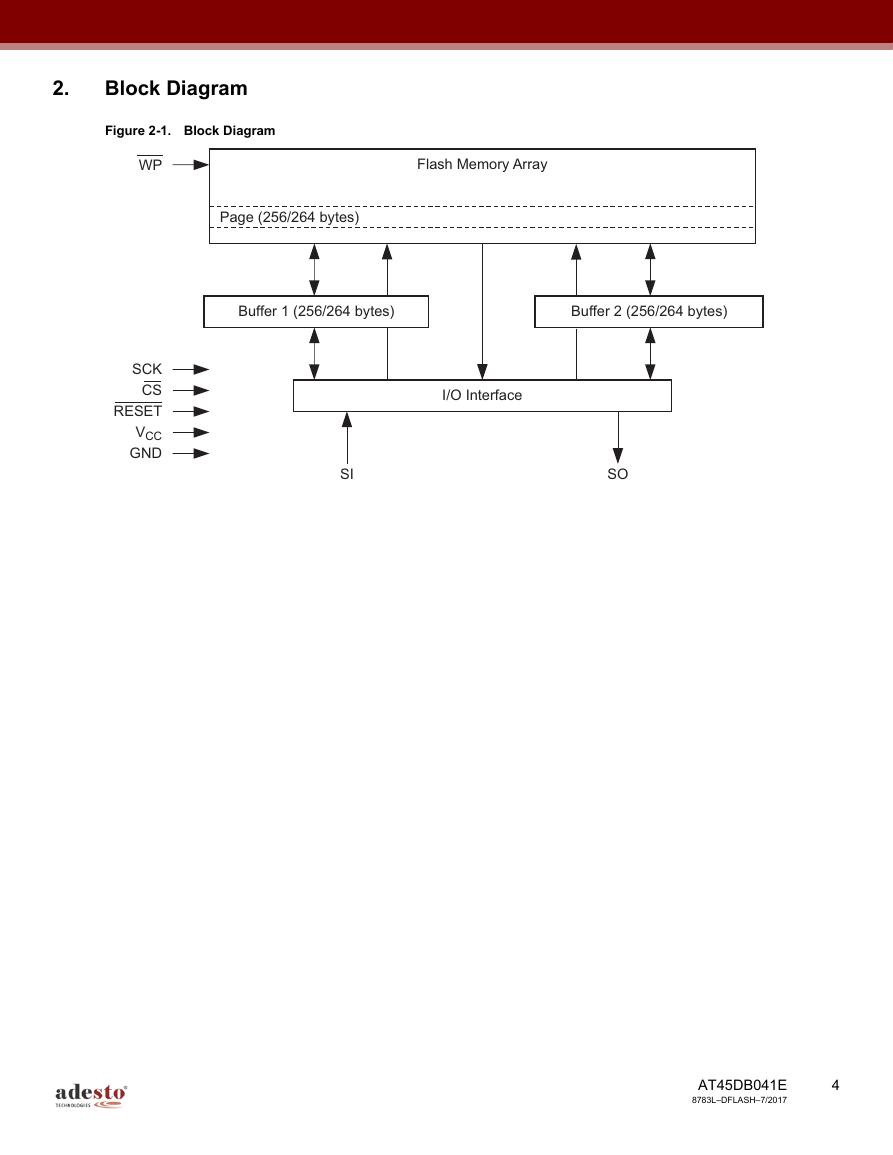
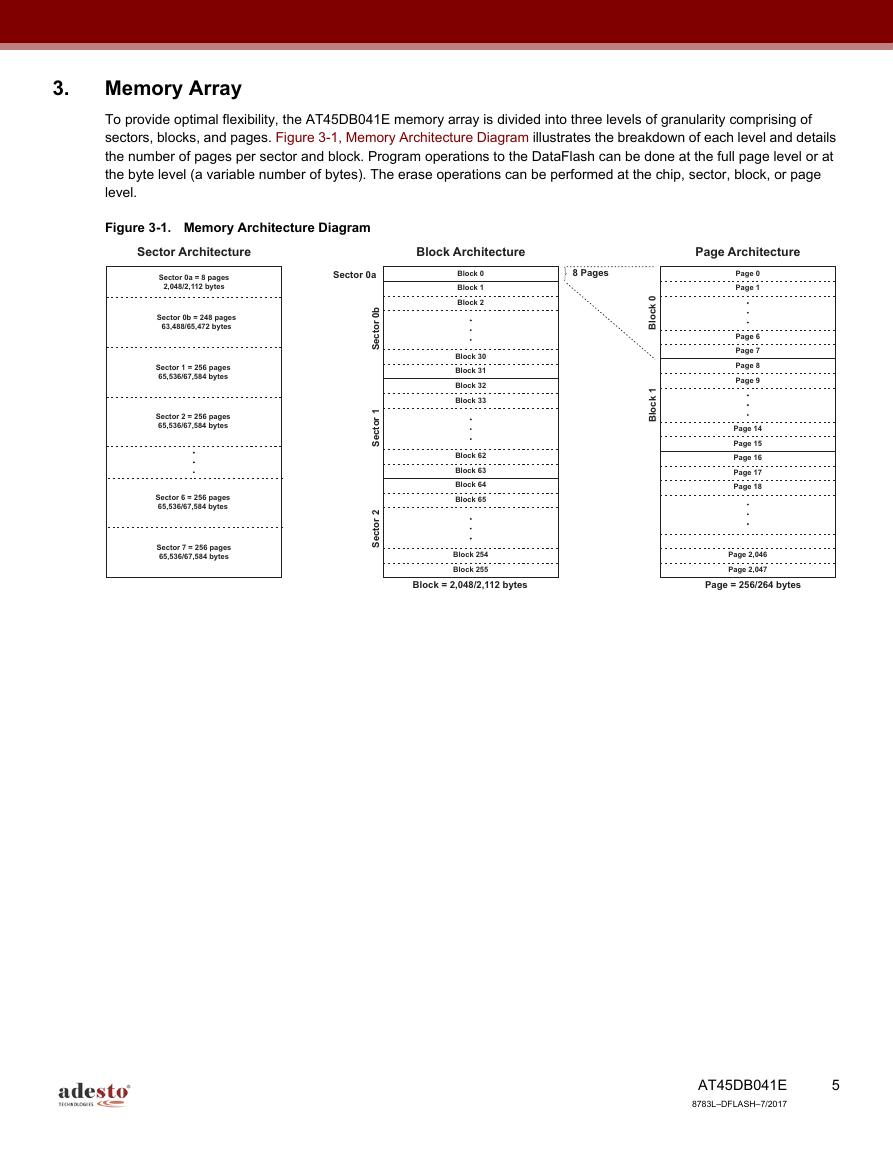
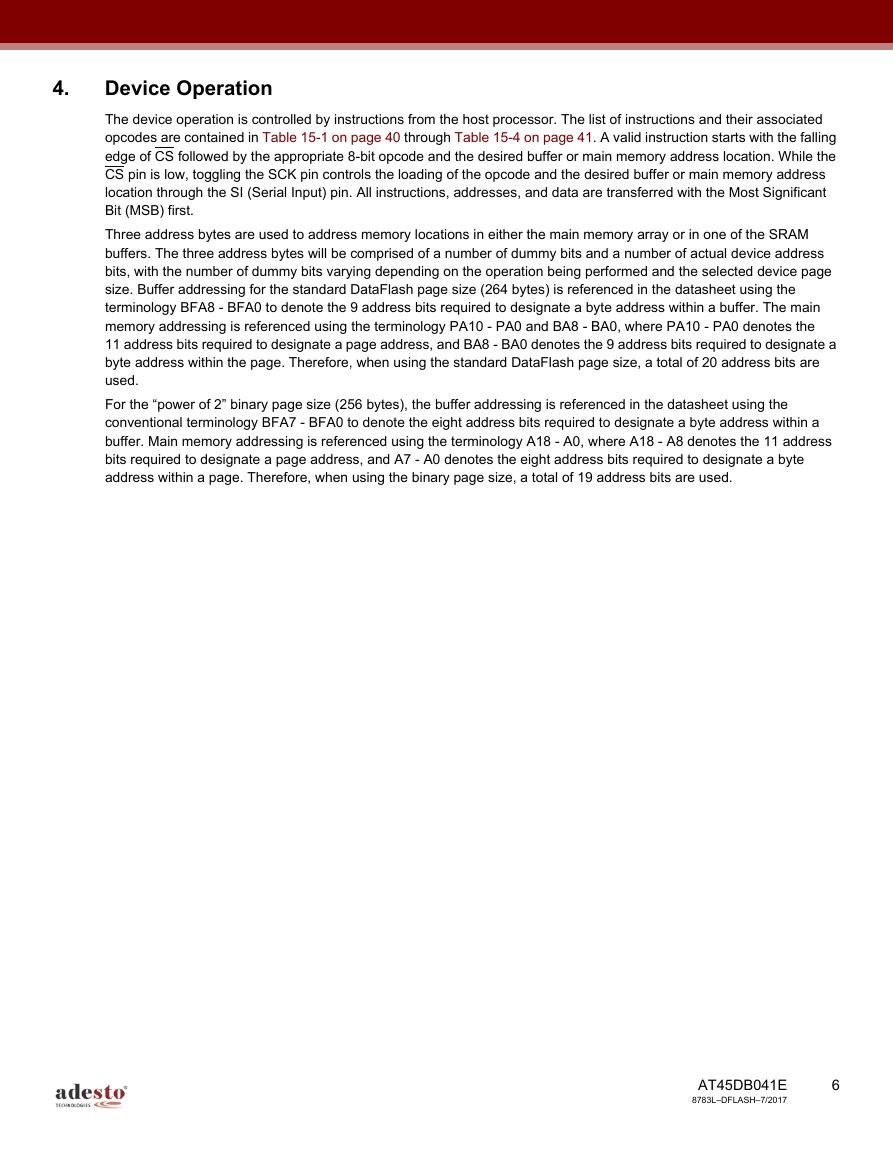
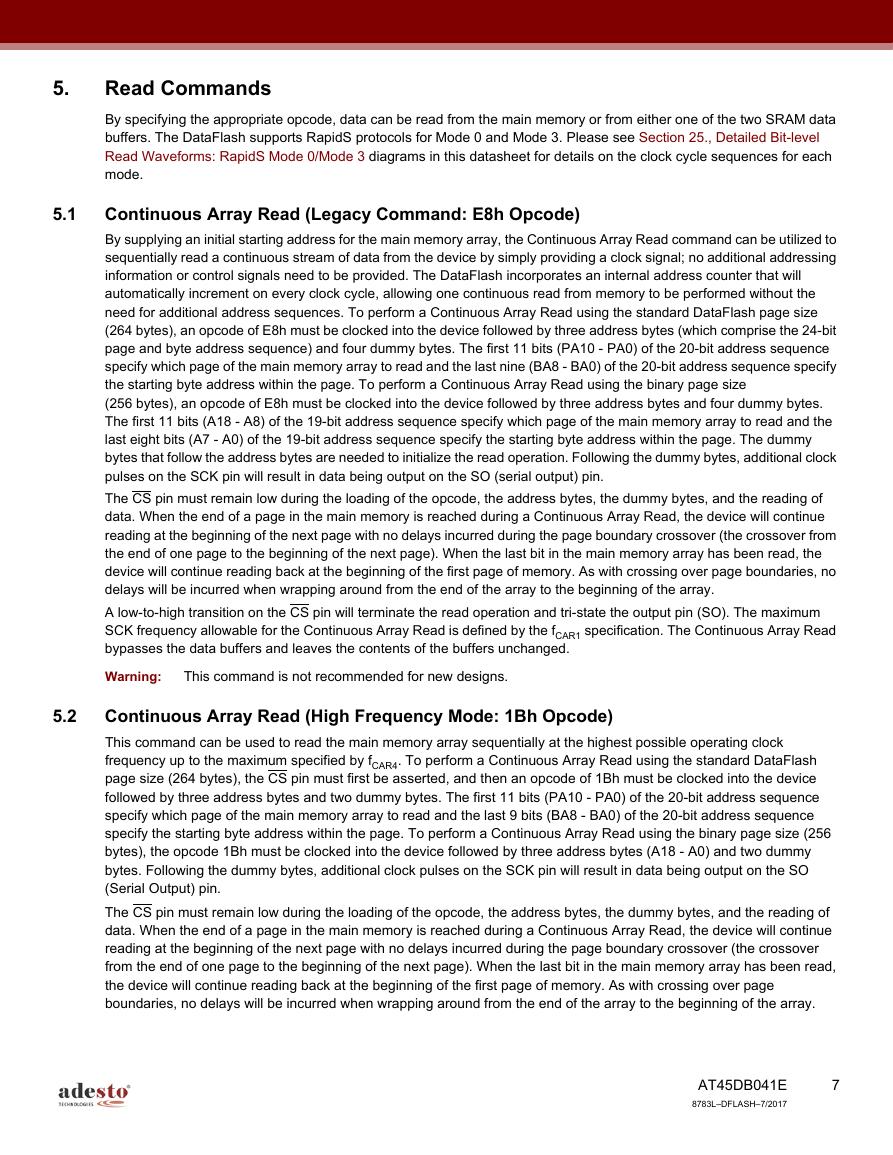
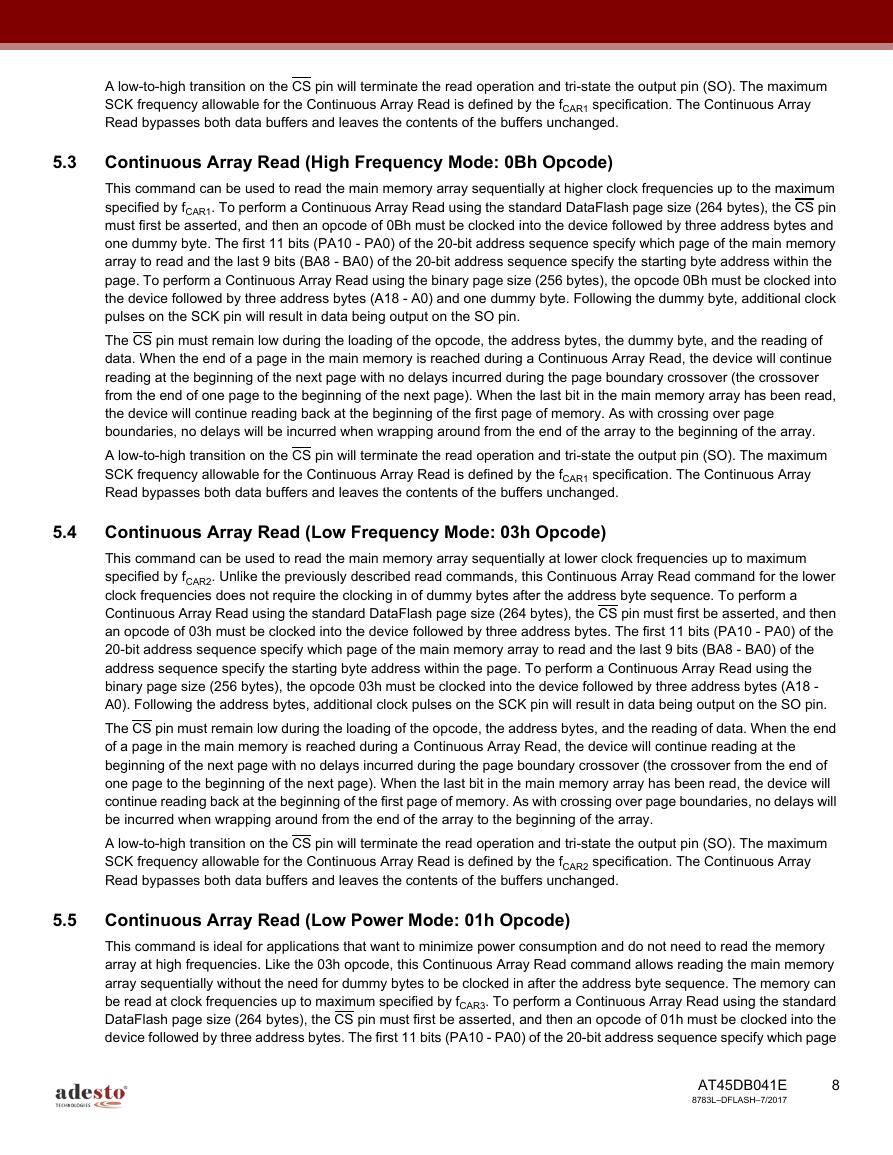








 V2版本原理图(Capacitive-Fingerprint-Reader-Schematic_V2).pdf
V2版本原理图(Capacitive-Fingerprint-Reader-Schematic_V2).pdf 摄像头工作原理.doc
摄像头工作原理.doc VL53L0X简要说明(En.FLVL53L00216).pdf
VL53L0X简要说明(En.FLVL53L00216).pdf 原理图(DVK720-Schematic).pdf
原理图(DVK720-Schematic).pdf 原理图(Pico-Clock-Green-Schdoc).pdf
原理图(Pico-Clock-Green-Schdoc).pdf 原理图(RS485-CAN-HAT-B-schematic).pdf
原理图(RS485-CAN-HAT-B-schematic).pdf File:SIM7500_SIM7600_SIM7800 Series_SSL_Application Note_V2.00.pdf
File:SIM7500_SIM7600_SIM7800 Series_SSL_Application Note_V2.00.pdf ADS1263(Ads1262).pdf
ADS1263(Ads1262).pdf 原理图(Open429Z-D-Schematic).pdf
原理图(Open429Z-D-Schematic).pdf 用户手册(Capacitive_Fingerprint_Reader_User_Manual_CN).pdf
用户手册(Capacitive_Fingerprint_Reader_User_Manual_CN).pdf CY7C68013A(英文版)(CY7C68013A).pdf
CY7C68013A(英文版)(CY7C68013A).pdf TechnicalReference_Dem.pdf
TechnicalReference_Dem.pdf